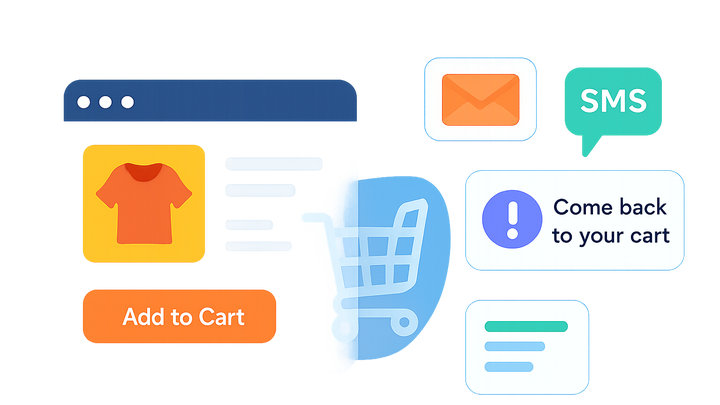Published on 2025-06-29T21:34:36Z
What Is Abandoned Cart Recovery? Strategies & Examples
Abandoned Cart Recovery is the process of re-engaging online shoppers who add products to their cart but leave your site without buying. It uses targeted messages—via email, SMS, on-site pop-ups, or ads—to coax customers back and complete their purchase. For e-commerce sites focused on CRO, UX, and SEO, an optimized recovery workflow can convert up to 15% of otherwise lost sales. By identifying UX friction points and leveraging customer behavior insights, teams can craft personalized campaigns that feel helpful rather than intrusive. Tools like Prevue.me provide actionable critiques on checkout flow, messaging content, and accessibility considerations to maximize lead generation and revenue.
Abandoned cart recovery
Targeted campaigns to win back customers who abandon carts, boosting revenue by capturing up to 15% of lost sales.
Why Abandoned Cart Recovery Matters
Recovering abandoned carts directly impacts your bottom line. With average abandonment rates near 70%, even small improvements yield substantial revenue. This section explains the core benefits and business case for investing in recovery tactics.
-
Revenue recapture
Targeted recovery flows typically reclaim 10–15% of lost sales, turning would-be misses into real revenue.
- Industry benchmarks:
E-commerce stores see cart abandonment rates around 69.8%, leaving vast revenue on the table.
- Roi potential:
Well-timed email campaigns can yield \(5–\)10 for every $1 spent.
- Industry benchmarks:
-
Improved customer experience
Personalized reminders help customers finish purchases smoothly, enhancing satisfaction and loyalty.
- Contextual messaging:
Referencing specific products or past behavior increases relevance and click-throughs.
- Multi-channel touchpoints:
Combining email, SMS, pop-ups, and ads ensures you reach customers in their preferred channel.
- Contextual messaging:
Common Recovery Strategies
Different tactics address various customer preferences and behaviors. Below are the most effective channels and best practices.
-
Email reminders
The most popular method. Send a series of 2–3 emails within 24–48 hours to gently remind, highlight benefits, and offer incentives.
- First reminder:
Within 1 hour: friendly nudge with product image.
- Second reminder:
24 hours later: emphasize benefits and social proof.
- Final reminder:
48 hours later: include a time-limited discount or free shipping.
- First reminder:
-
Sms notifications
Higher open rates than email but requires explicit opt-in and concise copy.
- Timing:
1–2 hours after abandonment for best results.
- Compliance:
Adhere to TCPA and GDPR to avoid penalties.
- Timing:
-
Exit-intent pop-ups
On-site messages triggered when a user moves their cursor toward the close button or address bar.
- Message design:
Clear headline, minimal form fields, strong CTA.
- Offer types:
Discounts, free shipping, or newsletter sign-up in exchange for email.
- Message design:
-
Retargeting ads
Display ads across social and web networks to remind visitors of abandoned items.
- Dynamic product ads:
Show the exact items left in cart for higher relevance.
- Audience segmentation:
Segment by cart value, product category, or engagement level.
- Dynamic product ads:
Implementing Recovery with SaaS Tools
SaaS platforms make setup and optimization fast. Here’s how top tools streamline your recovery campaigns.
-
Prevue.me
Provides deep UX and CRO critiques, pinpointing friction in your checkout flow and suggesting actionable fixes.
- Ux insight reports:
Highlight design and accessibility issues that drive abandonments.
- Email & sms templates:
High-conversion, customizable templates ready to deploy.
- Integration snippet:
Add this to your site to enable recovery features:
<script src="https://prevue.me/widget.js" data-site="YOUR_SITE_ID"></script>
- Ux insight reports:
-
Klaviyo
Leverages behavioral data to automate segmented email flows, track performance, and personalize content dynamically.
- Flow builder:
Drag-and-drop editor for multi-step recovery sequences.
- Dynamic variables:
Automatically pull in product names, images, and prices.
- Flow builder:
-
Omnisend
An omnichannel platform combining email, SMS, and push notifications with prebuilt recovery workflows.
- Prebuilt automations:
Ready-to-use recipes for abandoned cart sequences.
- Segmentation:
Target based on cart value, purchase history, and engagement.
- Prebuilt automations:
Best Practices & Optimization Tips
Apply these tactics to fine-tune your recovery campaigns and maximize conversion rates.
-
Personalization
Use the shopper’s name, product images, and tailored copy to increase relevance.
- Behavioral triggers:
Fire messages based on specific user actions (e.g., adding high-value items).
- Behavioral triggers:
-
Strategic incentives
Offer discounts or free shipping judiciously to avoid margin erosion.
- Tiered offers:
Increase incentives for higher cart values to boost average order value.
- Tiered offers:
-
A/b testing
Continuously test subject lines, send times, and designs to discover top-performing variations.
- Key variables:
Subject lines, CTAs, email layouts, and timing.
- Key variables:
Measuring Success
Track these metrics to evaluate performance and guide continuous improvement.
-
Recovery rate
The percentage of abandoned carts that convert after recovery efforts.
- Calculation:
(Recovered Carts / Total Abandoned Carts) × 100
- Calculation:
-
Revenue per campaign
Total revenue attributed to recovery messages over a given period.
- Reporting:
Use tool dashboards to monitor daily, weekly, and monthly revenue.
- Reporting:
-
Engagement metrics
Email open rates, click-through rates, and SMS response rates reveal message effectiveness.
- Benchmark comparison:
Aim for 40–50% open rates and 10–15% click-through rates.
- Benchmark comparison:
